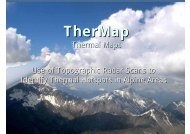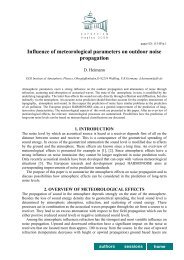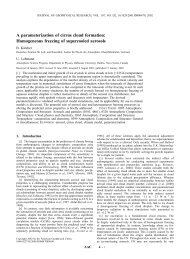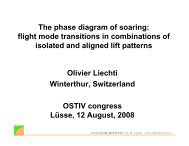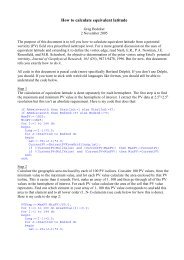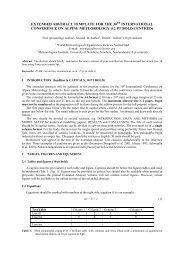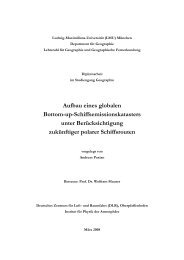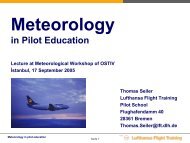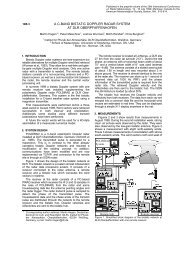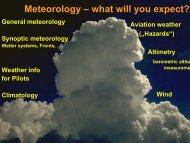turbulent dispersion of aircraft exhausts in regions of breaking ...
turbulent dispersion of aircraft exhausts in regions of breaking ...
turbulent dispersion of aircraft exhausts in regions of breaking ...
Create successful ePaper yourself
Turn your PDF publications into a flip-book with our unique Google optimized e-Paper software.
Turbulent <strong>dispersion</strong> <strong>of</strong> <strong>aircraft</strong> <strong>exhausts</strong> 3109<br />
The most remarkable feature <strong>of</strong> the sequence shown<br />
<strong>in</strong> Fig. 2 is the rapid horizontal spread <strong>of</strong> the lower<br />
portions <strong>of</strong> all three plumes <strong>in</strong>to the downstream<br />
direction while their upper portions rema<strong>in</strong> almost<br />
stationary. The weak deformation and advection <strong>of</strong><br />
the upper parts is a product <strong>of</strong> the nearly zero horizontal<br />
velocity close to the critical level. However,<br />
there is a horizontal drift <strong>of</strong> the red (black) plume<br />
towards right (left) due to the wave-<strong>in</strong>duced acceleration<br />
<strong>of</strong> the mean flow. This additional advection fully<br />
affects the uppermost portion <strong>of</strong> the red plume and<br />
only the lower portions <strong>of</strong> the blue and black ones.<br />
The result<strong>in</strong>g advection which is modified by waves<br />
and dependent on height forms the characteristic<br />
S-shape <strong>of</strong> both plumes (Figs 2b and c). The lower<br />
portions <strong>of</strong> the concentration distributions are controlled<br />
by shear deformation and their structures rem<strong>in</strong>d<br />
<strong>of</strong> f<strong>in</strong>d<strong>in</strong>gs by Du¨ rbeck and Gerz (1996) where<br />
the prescribed uniform shear causes a symmetrical<br />
stretch<strong>in</strong>g <strong>of</strong> isocontours with respect to the centre <strong>of</strong><br />
mass. In the present study, the horizontal spread<br />
depends strongly on the local w<strong>in</strong>d field, i.e. on the<br />
<strong>in</strong>dividual location <strong>of</strong> plume release. The vertical<br />
spread depends on the horizontal release position,<br />
too. In this stage <strong>of</strong> flow evolution, the vertical spread<br />
is not yet affected by three-dimensional <strong>turbulent</strong><br />
motions. The vertical expansion is ma<strong>in</strong>ly produced<br />
by wave-<strong>in</strong>duced vertical motions (upwards/downwards<br />
for flows <strong>in</strong> the luv/lee <strong>of</strong> the crest) that transport<br />
exhaust gases <strong>in</strong>to layers <strong>of</strong> different horizontal<br />
velocity. The height-vs-time plots <strong>of</strong> the locations <strong>of</strong><br />
maximum concentration confirm that the outer<br />
plumes undergo the most vigorous vertical excursions<br />
(Fig. 4a) : the red (black) plume is f<strong>in</strong>ally displaced<br />
upwards (downwards) whereas the slowly dispers<strong>in</strong>g<br />
blue plume rema<strong>in</strong>s essentially at the same height.<br />
The <strong>dispersion</strong> <strong>of</strong> <strong>aircraft</strong> <strong>exhausts</strong> emitted at<br />
t " 116 m<strong>in</strong> (which is six m<strong>in</strong>utes later than the time<br />
at which the fields are shown <strong>in</strong> Fig. 2) reveals the<br />
dom<strong>in</strong>ant <strong>in</strong>fluence <strong>of</strong> the beg<strong>in</strong>n<strong>in</strong>g <strong>turbulent</strong> diffusion,<br />
esp. that <strong>of</strong> the black plume (cf. Fig. 3). Initially,<br />
its <strong>dispersion</strong> evolves similarly as <strong>in</strong> the previous<br />
example. In addition, there occurs a horizontal spread<br />
towards the positive x-direction due to the overturn<strong>in</strong>g<br />
wave <strong>in</strong> this region. It is the <strong>turbulent</strong> breakdown<br />
<strong>of</strong> this wave that mixes and dilutes this plume very<br />
quickly (Figs 3c and d). Likewise, separated portions<br />
<strong>of</strong> the other plumes that are advected <strong>in</strong>to the break<strong>in</strong>g<br />
region get diffused more <strong>in</strong>tense than their almost<br />
stationary parts. Later, smaller scale, shear <strong>in</strong>duced<br />
rolls dilute these rema<strong>in</strong><strong>in</strong>g coherent plume <strong>regions</strong><br />
with ambient air. At the end, the concentration distributions<br />
<strong>of</strong> all plumes are much more diluted compared<br />
to plumes emitted at earlier times. Obviously,<br />
the spread <strong>of</strong> the plumes dom<strong>in</strong>ated by advection is<br />
substituted by <strong>turbulent</strong> mix<strong>in</strong>g <strong>in</strong> the break<strong>in</strong>g region<br />
at this stage. The height-vs-time plot <strong>in</strong> Fig. 4b<br />
exhibits the same vertical thickness <strong>of</strong> the layer and<br />
altitude <strong>of</strong> plume maxima at late times. This vertical<br />
uniformity is generated by the violent vertical mix<strong>in</strong>g<br />
Fig. 4. Height-time plots for the horizontally averaged concentration<br />
fields <strong>of</strong> the plume evolution shown <strong>in</strong> Figs 2 (top)<br />
and 3 (bottom). The coloured <strong>regions</strong> mark layers where the<br />
dimensionless concentration is greater than 1.1, the solid<br />
l<strong>in</strong>es are for c"0.5. The colours refer to the three plumes<br />
released at different horizontal positions.<br />
and the absence <strong>of</strong> wave-like motion <strong>in</strong> the <strong>turbulent</strong><br />
region. In summary, the structure <strong>of</strong> the concentration<br />
distribution <strong>of</strong> the dispers<strong>in</strong>g exhaust gases depends<br />
strongly on the time and location <strong>of</strong> plume release<br />
relative to the state <strong>of</strong> the turbulence production by<br />
the break<strong>in</strong>g gravity waves.<br />
3.3. Diffusivities<br />
In order to quantify the mix<strong>in</strong>g properties, this<br />
section presents the time series <strong>of</strong> the coord<strong>in</strong>ates <strong>of</strong><br />
the centre <strong>of</strong> mass (x , z ) (shown <strong>in</strong> Fig. 5) as well as<br />
<br />
those <strong>of</strong> the horizontal and vertical variances σ and <br />
σ (shown <strong>in</strong> Fig. 6) <strong>of</strong> each plume. The statistics are<br />
<br />
based on the data <strong>of</strong> the y-averaged, two-dimensional<br />
concentration fields.<br />
The <strong>in</strong>fluence <strong>of</strong> advective effects on the locations <strong>of</strong><br />
centre <strong>of</strong> the gravity (x , z ) is revealed by their horizontal<br />
and vertical displacements displayed <strong>in</strong> Fig. 5.<br />
<br />
Shortly after their emission, all outer plumes are<br />
moved vertically accord<strong>in</strong>g to the local vertical velocity<br />
field (the black plume upwards, the red plume<br />
downwards). Due to the simultaneous horizontal<br />
drift, the plumes enter <strong>regions</strong> <strong>of</strong> different vertical<br />
velocity or zones where <strong>turbulent</strong> mix<strong>in</strong>g <strong>in</strong>itiates<br />
strong vertical displacements. Altogether, the centres<br />
<strong>of</strong> mass <strong>of</strong> the red plumes are raised and shifted<br />
upstream, whereas those <strong>of</strong> the black plumes descend<br />
after a long downstream advection. As expected, the<br />
blue plumes are only slightly affected by advective<br />
processes. The horizontal excursions are the smaller



